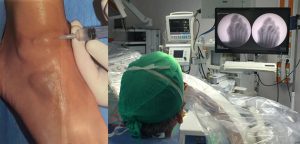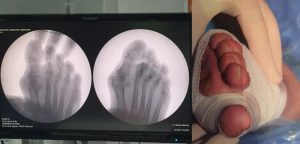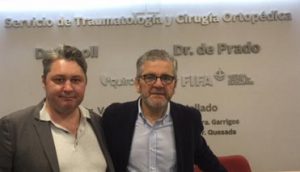Percutaneous surgery
Principles
Percutaneous surgery developed in Europe in the late 1990s. It saw her scientific principles codified, under the aegis of Dr De Prado, after being initiated by podiatrists, Spanish and American.
Doctor Greffe, has been interested from the beginning of his training in these innovative techniques. He completed his training during his studies in Murcia, Spain with Dr De Prado, in order to improve his knowledge of percutaneous surgery.

The surgical act
The surgical procedure is performed in ambulatory hospitalization (entrance in the morning at the clinic, and exit in the early afternoon), with loco-regional anaesthesia of the foot. This anesthesia is performed by your surgeon or the anesthesiologist, for at least 48 hours of foot sleep.
The patient comes out of the operating room, able to walk on his foot operated. You can then unfold the step, under cover of a dedicated shoe.
All the surgical gestures are made through incisions of a few millimetres. After one week, the healing is obtained, and the patient himself does the reconstruction of his bandages.
This percutaneous technique does not, however, shorten the post-operative recovery time due to edema (swelling of the foot). Its advantage come from the fact that it allows a natural adaptation of the foot to the walk.

There is no material in place in percutaneous surgery. Stability comes from not touching adjacent tissues (such as tendons, ligaments, or joint structures).
However, this is action is only conceivable in minor to medium deformations. Moreover, percutaneous surgery can only concern one foot at a time.
Surgical technique
The procedure takes place in different stages, under permanent X-ray control (fluoroscopy):
- Long-term anesthesia to put the 4 nerves in the foot to sleep for 48-72 hours
- Performing bunion milling with the surgical cutter.
- Release of the lateral joint capsule in order to mobilize the big toe.
- A 15° triangle osteotomy of the first metatarsal bone, possibly supplemented by a total section.
- Possibility if a persistent deformation of a complementary osteotomy of the 1st phalange
- Bandage with a spacer between 1st and 2nd toes to keep foot in anatomical position.
Other Indications
Percutaneous surgery can extend to other areas of foot surgery, such as claw toes, hyper-supportive pain, or a “bunionette”.
The choice of a percutaneous technique is in no way related to the patient’s aesthetic concerns. The recovery and complications are identical to the conventional techniques or even longer (especially edema). Also, it is up to the surgeon to choose the most suitable technique for your personal situation.

Specific Complications to percutaneous surgery
Sensitive disorders. It is possible to damage sensitive nerves not visible by percutaneous technique, as opposed to open-sky surgery.


